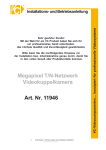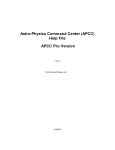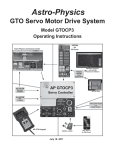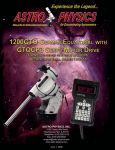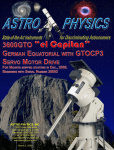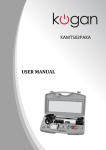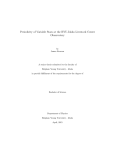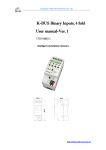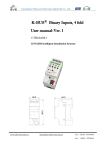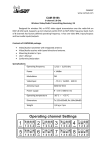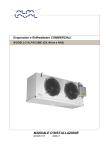Download PDF (included in install)
Transcript
PulseGuide for Astro-Physics GTO Series Mounts User Manual for Version 1.37 March 6 2008 PulseGuide v1.37 User Guide and Manual – Copyright © 2002-2008 Ray Gralak 1 Introduction ............................................................................................................. 4 Software Licensing Agreement ............................................................................... 5 Installation............................................................................................................... 7 Features.................................................................................................................. 8 Changes/New Features/Bug Fixes ......................................................................... 9 Version 1.37 – March 6, 2008 ............................................................................. 9 Version 1.36 – February 6, 2008 ......................................................................... 9 Version 1.35 – January 31, 2008......................................................................... 9 Version 1.30 – June 27, 2004 ............................................................................. 9 Version 1.26 – January 9, 2004......................................................................... 10 Version 1.25 – November 22, 2003................................................................... 10 Version 1.21 (Beta) – October 3, 2003............................................................. 10 Version 1.20 – June 1, 2003 ............................................................................. 10 Version 1.10 ...................................................................................................... 11 Getting Started .................................................................................................. 13 Summary of Pages............................................................................................ 17 Using a planetarium program with PulseGuide ..................................................... 19 Connect Page ....................................................................................................... 20 Firmware Version .............................................................................................. 21 Init Mount .......................................................................................................... 22 Help................................................................................................................... 23 Log Window....................................................................................................... 23 About................................................................................................................. 23 Additional Config options................................................................................... 24 Status Bar ......................................................................................................... 26 Time Page ............................................................................................................ 27 Time and Time Zone ......................................................................................... 27 Set Meridian Delay ............................................................................................ 28 Site Page .............................................................................................................. 30 Get From Mount ................................................................................................ 30 Send to Mount ................................................................................................... 30 Save .................................................................................................................. 31 Edit .................................................................................................................... 31 Delete................................................................................................................ 31 Locations.dat ..................................................................................................... 31 Park/Rate Page..................................................................................................... 32 Tracking Rates .................................................................................................. 32 Delayed Stop or Park Mount ............................................................................. 33 Unparking the mount ......................................................................................... 34 Parking the mount ............................................................................................. 36 If you need to stop a park.................................................................................. 37 Guide/Slew Page .................................................................................................. 38 Set Rates .......................................................................................................... 38 Move Scope ...................................................................................................... 38 Reorienting the Move Pushbuttons ................................................................... 39 PulseGuide v1.37 User Guide and Manual – Copyright © 2002-2008 Ray Gralak 2 Swapping Mount Move Directions ..................................................................... 39 STOP ................................................................................................................ 40 Set Slew Rate.................................................................................................... 40 GOTO/Sync....................................................................................................... 40 Pulse Guider Page................................................................................................ 41 Measure Rate Tool............................................................................................ 43 Pulse Guiding .................................................................................................... 44 Realtime Status ................................................................................................. 46 Trouble Shooting ............................................................................................... 47 PGConfig Page ..................................................................................................... 48 Use 0.25x Guide Rate up to .............................................................................. 48 Use 0.50x Guide Rate up to .............................................................................. 48 Use 1x Guide Rate up to ................................................................................... 48 Use 12x Guide Rate up to ................................................................................. 49 Max Pulses Per Second .................................................................................... 49 Use Defaults...................................................................................................... 49 PEM/Other Page................................................................................................... 50 Periodic Error Management .............................................................................. 50 Focus Control .................................................................................................... 51 Reticle ............................................................................................................... 51 Backlash............................................................................................................ 51 Backlash Tests .................................................................................................. 52 TPoint Page .......................................................................................................... 57 TPoint Resynchronization – Step 1 ................................................................... 57 TPoint Resynchronization – Step 2 ................................................................... 58 Troubleshooting .................................................................................................... 59 PulseGuide won’t connect and I know the COM Port is right. ........................... 59 Appendix A – ASTRO-PHYSICS COMMAND PROTOCOL FOR GTO MOUNTS (Version “D” or “KD”)............................................................................................. 60 Appendix B – AP Commands by Category ........................................................... 66 Appendix C – AP Park Positions........................................................................... 69 PulseGuide v1.37 User Guide and Manual – Copyright © 2002-2008 Ray Gralak 3 Introduction PulseGuide is a stand-alone Windows (98, ME, 2000, NT4, XP, Vista) utility that provides complete remote control of Astro-Physics GTO400, GTO600, GTO900, and GTO1200 mounts. It derives its name from its most distinctive feature, pulse guiding, which can improve unguided tracking. Specifically it can help correct tracking errors caused by polar misalignment and refraction. You can also train PulseGuide to track objects moving relative to the stars, such as asteroids, comets, and the moon. In addition to pulse guiding, PulseGuide also has many useful utility features. With just a few exceptions, it supports the serial Astro-Physics command protocol. PulseGuide requires a serial connection from your PC to your mount using a straight through DB9 cable. One end of the cable must have a female connector and the other end male. Cables as long as 100 feet or more should work provided the cable is made from high-quality shielded cable. Cables with twisted pair wires work best, such as those from Belden. Figure 1 PulseGuide v1.37 User Guide and Manual – Copyright © 2002-2008 Ray Gralak 4 Software Licensing Agreement The following statement must be read and agreed with before you can install this Software Product (PulseGuide). IMPORTANT, PLEASE READ CAREFULLY: THIS IS A LEGAL AGREEMENT BETWEEN YOU AND SIRIUS-IMAGING (RAY GRALAK) BY INSTALLING, COPYING, OR OTHERWISE USING THE SOFTWARE PRODUCT, YOU ARE AGREEING UNCONDITIONALLY TO BE BOUND BY THE TERMS OF THIS LICENSE AGREEMENT, EVEN IF THIS LICENSE AGREEMENT IS DEEMED A MODIFICATION OF ANY PREVIOUS ARRANGEMENT OR CONTRACT. IF YOU DO NOT AGREE TO THE TERMS OF THIS LICENSE AGREEMENT, DO NOT INSTALL OR USE THE SOFTWARE PRODUCT. 1. For the purposes of this License Agreement, “Software”, “Software Product” , or “Software Patch” refers to the computer software and associated media, printed materials, and “online” or electronic documentation, including any and all executable files, tutorials, help files, utilities, and other files that accompany this product. The Software Product is owned by Sirius-Imaging (Ray Gralak) and is protected by United States copyright laws, international copyright treaties, and all other applicable national laws. Title, ownership rights, and intellectual property rights in and to the software shall remain with Sirius-Imaging (Ray Gralak). The Software Product is licensed, not sold. There is no transfer to you of any title to or ownership of the Software, and this license shall not be construed as a sale of any right in the Software. 2. Other Restrictions. You may not reverse engineer, decompile, or disassemble the Software Product or make any attempt to discover the source code to the Software Product. Except as expressly permitted in this License Agreement or with written permission from Sirius-Imaging (Ray Gralak – [email protected]), the Software may not be used, copied, redistributed, retransmitted, published, sold, rented, leased, marketed, sublicensed, assigned, transferred, altered, or modified. 3. Liability. BECAUSE THE SOFTWARE PRODUCT IS LICENSED FREE OF CHARGE, THERE IS NO WARRANTY FOR THE SOFTWARE PRODUCT, TO THE EXTENT PERMITTED BY APPLICABLE LAW. EXCEPT WHEN OTHERWISE STATED IN WRITING THE COPYRIGHT HOLDERS AND/OR OTHER PARTIES PROVIDE THE SOFTWARE PRODUCT "AS IS" WITHOUT WARRANTY OF ANY KIND, EITHER EXPRESSED OR IMPLIED, INCLUDING, BUT NOT LIMITED TO, THE IMPLIED WARRANTIES OF PulseGuide v1.37 User Guide and Manual – Copyright © 2002-2008 Ray Gralak 5 MERCHANTABILITY AND FITNESS FOR A PARTICULAR PURPOSE. THE ENTIRE RISK AS TO THE QUALITY AND PERFORMANCE OF THE SOFTWARE PRODUCT IS WITH YOU. SHOULD THE SOFTWARE PRODUCT PROVE DEFECTIVE, YOU ASSUME THE COST OF ALL NECESSARY SERVICING, REPAIR OR CORRECTION. IN NO EVENT UNLESS REQUIRED BY APPLICABLE LAW OR AGREED TO IN WRITING WILL ANY COPYRIGHT HOLDER, OR ANY OTHER PARTY WHO MAY MODIFY AND/OR REDISTRIBUTE THE SOFTWARE PRODUCT AS PERMITTED ABOVE, BE LIABLE TO YOU FOR DAMAGES, INCLUDING ANY GENERAL, SPECIAL, INCIDENTAL OR CONSEQUENTIAL DAMAGES ARISING OUT OF THE USE OR INABILITY TO USE THE SOFTWARE PRODUCT (INCLUDING BUT NOT LIMITED TO LOSS OF DATA OR DATA BEING RENDERED INACCURATE OR LOSSES SUSTAINED BY YOU OR THIRD PARTIES OR A FAILURE OF THE SOFTWARE PRODUCT TO OPERATE WITH ANY OTHER SOFTWARE PRODUCTS), EVEN IF SUCH HOLDER OR OTHER PARTY HAS BEEN ADVISED OF THE POSSIBILITY OF SUCH DAMAGES. PulseGuide v1.37 User Guide and Manual – Copyright © 2002-2008 Ray Gralak 6 Installation After downloading the latest version of PulseGuide from the PulseGuide Home Page, you will need to unzip it to get to the setup EXE that is usually named PulseGuideVVV.EXE, where “VVV” is the version number. For example, version 1.37’s install EXE is PulseGuide137.EXE. The installation is very straightforward. Follow the install directions to complete the installation. After the installation completes a new program group, “PulseGuide”, will be available with links to run PulseGuide and to view documentation, etc. IMPORTANT INSTALLATION NOTES: 1. This new version does NOT uninstall any previous version of PulseGuide. If you do not plan to use an old version you can remove it with Add or Remove Programs in Windows Control Panel. 2. The installation directory for this version is now: “C:\Program Files\PulseGuide”. 3. To be Vista compatible PulseGuide’s working directory is now \\My Documents\Astro-Physics\PulseGuide. The HTML Help file (PulseGuide.chm) and Site information file (Locations.dat) are now located in this directory. 4. If you want to use site information from version 1.30 you must locate locations.dat and copy it to \\My Documents\AstroPhysics\PulseGuide. This file is usually located in c:\Program Files\PulseGuide v1.30. PulseGuide v1.37 User Guide and Manual – Copyright © 2002-2008 Ray Gralak 7 Features • • • • • • • • • • • • • • • • • • • • • Supports the AP serial command protocol. Pulse guiding - This corrects for drift due to mispolar alignment and refraction. Pulse guiding is an idea originally suggested by Roland Christen (founder of Astro-Physics) and implemented in this application. It works by sending precisely timed serial commands that make the mount move faster in RA and/or Dec for a short period (hence “pulses”). Declination axis tests that you can use to check the health of your mount’s declination axis. With one button Unpark, automatically setting the time, time zone, longitude, and latitude without ever needing to plug in the hand controller. PulseGuide will even detect that your mount is not initialized and ask to initialize it. Unpark from one of the AP park positions or your own Alt/Az One-button Park feature allows you to park the mount at its current position, one of the AP park positions, or a user-defined Alt/Az. Set guide/slew rates. Buttons to move the scope conveniently. A status bar that shows the scope’s position in RA/Dec (or Alt/Az), the side of mount that the scope is on, Local Sidereal time, and Object Hour Angle. Set the tracking rate (sidereal, lunar, solar, zero). Delayed stop or park of the mount so the scope will not hit the pier if you fall asleep or forget to shut down the scope. PEM (On/Off, record with timer). Set mount to PC Time and set Time Zone. Set a Meridian delay so the mount will not flip on a GOTO command. Convenient Site management. GOTO/Sync to RA/DEC coordinates. STOP button to stop a GOTO, if desired. TPoint resynchronization. This is a useful tool if you are using Software Bisque’s TheSky with a TPoint model and lose synchronization because you moved the scope by hand. Focus control including a counter to keep track of position. Reticle brightness control. Set mount backlash. Other miscellaneous features. PulseGuide v1.37 User Guide and Manual – Copyright © 2002-2008 Ray Gralak 8 Changes/New Features/Bug Fixes Version 1.37 – March 6, 2008 1. 2. Fixed install bug that asked to reinstall everytime PulseGuiude is run. Added reverse Dec/RA checkboxes in Measurement dialog. Version 1.36 – February 6, 2008 1. Fixed timing bug that may cause a queued command to be sent before a reply to the previous command is received. Version 1.35 – January 31, 2008 1. Added North/South field to Declination in Goto/Sync group box. 2. Fixed bug in Mount Initialization dialog – Slew rate is now initialized. 3. Add a button to load the current RA/Dec into the RA/Dec fields of the Goto/Sync group box. 4. Added “Init Mount” button to the Connect page. This allows you to initialize the mount at any time, and not just when the mount has not been initialized since power on. 5. After initialization the Last Sent Tracking Rate and Slew Rate fields are now filled in. 6. Fixed compatibility bug (with keypad firmware) when sending/receiving with East Longitude coordinates. 7. Updated Park/Unpark Alt/Az locations so that they work properly in North and South Hemispheres. 8. Better validation of received RA/Dec values. 9. On the PulseGuider tab show “N/A” in some PulseGuide fields when hardware supported tracking rates are used (GTOCP3). 10. Time Zone can now be entered in the range -11 to 23 hours (was 0 to 23). Version 1.30 – June 27, 2004 1. Added support for new GTOCP3 controller (firmware revision “F” and higher). 2. Pulse guiding now directly sets the Dec and RA rates in firmware for very precise rates. The old method of sending pulses to effectively adjust the rate is still supported for older firmware revisions. 3. Pulse guider direction automatically reverses if the mount is flipped. PulseGuide v1.37 User Guide and Manual – Copyright © 2002-2008 Ray Gralak 9 4. The Guide rate and Button rate can now be set independently like can be done in the AP keypad. 5. New program icon. 6. Miscellaneous other changes. Version 1.26 – January 9, 2004 1. Fixed Dec Test 3 which would only do one movement to the North before reversing to the South. 2. Fixed the focuser counter. It now decrements the counter when you press the “-“ button. Version 1.25 – November 22, 2003 1. Added a third Declination axis test. To do this test you must remove the declination axis cover and watch the gear train. Or, you can observe the motion at night by looking at a star with very high power. 2. The focuser control now has a position counter. When a button is pressed the focuser will be sent pulses slowly at first and will accelerate as you keep the button pressed. Version 1.21 (Beta) – October 3, 2003 1. A new comprehensive mount initialization dialog automatically pops up when the mount is detected in the un-initialized state after power is applied. 2. Added two Declination-axis backlash tests suggested by Roland to determine the health of your mount’s declination axis. Version 1.20 – June 1, 2003 1. Improved internal logic to prevent commands from overlapping. 2. Additional movement buttons, ability to rotate buttons. 3. New Measurement results dialog. 4. Park to AP Park Positions or user-defined Alt/Az. 5. Unpark from AP Park Positions or user-defined Alt/Az. 6. Improved accuracy when setting and retrieving time. 7. Focus control. 8. Reticle brightness control. 9. Backlash control. 10. Local serial time displayed in status bar (instead of sidereal time). 11. The Measure Rate Tool now calculates the RA and Dec rates correctly. PulseGuide v1.37 User Guide and Manual – Copyright © 2002-2008 Ray Gralak 10 12. The serial commands are now queued so they cannot overlap each other. Stricter error checking is done on responses. 13. PulseGuide no longer disconnects often. 14. Hour-Angle in status bar is now correct. 15. Numerous minor user interface changes. Version 1.10 1. New status bar on the bottom of the window displays RA, DEC, Side of mount the scope is on, the current sidereal time, and the hour angle (angle of the scope relative to the meridian). The status bar is not part of any of PulseGuide’s tabs so it displays all time while the mount is connected. 2. Optionally, the PulseGuide application will place itself always on top of other windows. 3. New Locations tab allows user to save and restore an arbitrary number of locations (longitude/latitude). PulseGuide can easily send whichever location you choose to the mount. 4. New TPoint tab allows you to resynchronize your mount to your TPoint(TM) Model in TheSky(TM). 5. In addition to stopping the mount the Delayed Stop feature can now Park the mount. Parking de-energizes the motors so that autoguider signals or serial commands will not move the mount. 6. When unparking the mount the mount’s longitude, latitude, and time zone are sent in addition to the PC time. 7. You can swap the positions of the N/S and E/W move scope buttons. 8. Goto manually entered coordinates. 9. Sync to manually entered coordinates 10. STOP movement button to stop a GOTO if necessary 11. When one of the Set Guide/Centering Rate buttons is pressed the rate is now displayed in the center of the Move Scope buttons (in addition to the Last Sent edit box). PulseGuide v1.37 User Guide and Manual – Copyright © 2002-2008 Ray Gralak 11 12. PulseGuide now updates RA and Dec every second instead of every other second. 13. Removed the ALT/AZ option (tell me if you want it back in). 14. Unpark now sends location and time zone in addition to time (which was all that PulseGuide sent in v1.10). In particular, this is what PulseGuide sends when you click Unpark (commands sent in this order): Longitude Latitude Local Time Time Zone Date Unpark command Set Sidereal Rate PulseGuide v1.37 User Guide and Manual – Copyright © 2002-2008 Ray Gralak 12 Getting Started After starting PulseGuide but before connecting to the mount you will need to connect a serial cable to the mount and determine which COM port to select. PulseGuide requires a serial connection from your PC to your mount using a straight through DB9 cable. One end of the cable must have a female connector and the other end male. Cables as long as 100 feet or more should work provided the cable is made from high-quality shielded cable. Cables with twisted pair wires work best, such as those from Belden. Connect the male end of the serial cable to one of the two serial ports on your mount. It does not matter which you use. Once connected, you can start PulseGuide from its desktop icon or from the Start menu. You should see something like the following Figure: Figure 2 – Before connecting Next, you must select the appropriate COM port. If you are using a desktop or notebook PC with a single serial port it is likely that it is COM1. Desktop PC’s with two serial ports usually are COM1 and COM2. If you are using a USB to serial port adapter, such as the Iogear GUC232A you can find out in the Windows Device Manager which COM port it is using. PulseGuide v1.37 User Guide and Manual – Copyright © 2002-2008 Ray Gralak 13 If you are still unsure of the COM port then make sure that “Ignore Mount Timeouts” is unchecked then start trying COM ports starting with COM1. If a port is invalid or opened by another application PulseGuide will report an error opening the port, or will not succeed. Once connected a number of additional page tabs appear. If the port is really communicating to the mount the status bar will fill with the RA, DEC, side of mount, etc., like this: Figure 3 – Successful connection PulseGuide v1.37 User Guide and Manual – Copyright © 2002-2008 Ray Gralak 14 If PulseGuide detects that the mount is in the powered up and unparked state (RA=0, Dec=90) it will automatically pop up the Initialization dialog shown below. From this dialog you can set up and review which parameters PulseGuide will immediately configure. Supported parameters are unpark position, Site, Time Zone, Tracking Rate, Guide Rate, Slew Rate, Dec and RA backlash, and PEM enable. All parameters that you set will be remembered and displayed in this dialog the next time this dialog displays (which will be the next time you power up the mount). Click Initialize to automatically initialize the mount. If you decide to click No you can always initialize the mount later by clicking the Init Mount button on the Connect page. PulseGuide v1.37 User Guide and Manual – Copyright © 2002-2008 Ray Gralak 15 If you have not set up a default site yet, you will get this dialog: Despite this warning it is usually OK to click OK if you know that the last used location of the mount was set properly (from either the keypad or from a planetarium program or PulseGuide). PulseGuide v1.37 User Guide and Manual – Copyright © 2002-2008 Ray Gralak 16 Summary of Pages Here is a summary of what each page does. For more information on a page, click the link: Connect Page – The initial page with connect options. The firmware version will display here when connected. You can click the Help button to get program help. You can also access help for any page by pressing F1 with that page displayed. Time Page – You can set or get your mount’s time and time zone. You can also set a simulated meridian delay on this page. Site Page – You can define the longitude and latitude of sites you visit. You can also get the longitude and latitude currently set in your mount. The sites you define on this page can be set up automatically when you unpark your mount in the Park/Rate Page. Park/Rate Page – You can set your tracking rate with one of the built-in rates the mount supports (sidereal, lunar, solar, zero). You can also do a one-button unpark and park of your mount. When parking, you can have your mount slew to one of the AP Park Positions or an Alt/Az of your choice. Lastly, you can set up a delayed stop of your mount when imaging. This will stop the mount after a number of hours so that your mount will not hit the pier if you fall asleep or forget to stop it. Guide/Slew Page – You can set the mount’s guide, centering, and slew rates. You can move the mount around with buttons. You can do a GOTO to a RA/Dec coordinate or SYNCH on a RA/Dec coordinate. Pulse Guider Page – You can use the pulse-guiding feature from this page. PG Config Page – You can adjust the pulse-guiding configuration parameters from this page. PEM/Other Page – You can record a periodic error (PEM) cycle, turn on and off PEM, control focus through the AP focus port, adjust reticle brightness, and set RA and Dec backlash. PulseGuide v1.37 User Guide and Manual – Copyright © 2002-2008 Ray Gralak 17 TPoint Page – This page allows you to resynchronize with your Software Bisque TPoint model, should you accidentally move your scope by hand or otherwise loose synchronization. PulseGuide v1.37 User Guide and Manual – Copyright © 2002-2008 Ray Gralak 18 Using a planetarium program with PulseGuide There are several ways to simultaneously use PulseGuide and a planetarium program such as TheSky, Desktop Universe, MegaStar, etc. 1. You can use the second serial port on your mount and a second COM port on your PC. This provides dedicated connections for both applications so you can use both PulseGuide and your planetarium program simultaneously. However this obviously requires two serial cables and COM ports on your PC, which might not be available. 2. You can use a single serial cable and connect to each program when needed then disconnect when done. 3. The Astro-Physics Command Center, which is still in development at this time (Feb 2008), will present multiple virtual port connections, which will allow you to connect several applications simultaneously through a single serial port connection. PulseGuide v1.37 User Guide and Manual – Copyright © 2002-2008 Ray Gralak 19 Connect Page Figure 4 below shows PulseGuide as it comes up. If this is your first time using PulseGuide please also take a look at the Getting Started section. In order to control your Astro-Physics GTO mount you must have a serial port connection (or USB to serial adapter) to your mount. For most PC’s and laptops you will need to connect a “straight through” DB9 to DB9 Male to Female cable. All Astro-Physics GTO mounts have two serial ports so if you also need to control your mount with TheSky or other planetarium software then you will need a second serial port on your PC and another cable. Again, you can use a USB to serial adapter if your PC does not have a second serial port. Iogear makes one that works well (GUC232A). Figure 4 Once you have connected your PC to the mount you need to select the serial port that you are using. If you have only one serial port then the port is likely COM1. If you have two ports then they are probably COM1 and COM2. If in doubt, start with COM1 and increase the port number sequentially. PulseGuide v1.37 User Guide and Manual – Copyright © 2002-2008 Ray Gralak 20 When testing a port for the first time, make sure to uncheck the checkbox Ignore Mount Timeouts. PulseGuide will report an error if the mount does not respond. If the mount does respond, the Firmware version will display and PulseGuide will fill the status bar with information as shown in figure 5: Figure 5 However, if the mount does not respond then PulseGuide will automatically disconnect in about 15 seconds. If this happens, check your cable and/or try another serial port until you have found the correct port. Firmware Version The latest firmware available for general distribution as of January 2008 is version “L” in the brand new mounts with GTOCP3 control boxes. Version “E” or “E1” is the latest for previous generations. Upgrades to the latest control box are available from AP. PulseGuide v1.37 User Guide and Manual – Copyright © 2002-2008 Ray Gralak 21 Init Mount Pressing this button brings up the Mount Initialization dialog. You can initialize the mount again from this dialog. By default Unpark will be unchecked in case the mount was already initialized. Click Initialize to initialize the fields that are checked. Click Cancel to skip initializing the mount. PulseGuide v1.37 User Guide and Manual – Copyright © 2002-2008 Ray Gralak 22 Help Pressing this button brings up help. Internet Explorer 4 or later must be installed for help to work. You can also press F1 to activate page specific help. Log Window Pressing the Log Window button will open the Command Log window. This may be useful in debugging communications to your mount. Commands sent to the mount are in green and replies from the mount are in blue. If a command times out a message will display in red. The decimal number at the start of each line is the relative time in seconds since the first command was printed. The time is in seconds and is accurate to the nearest millisecond. If any command failed to produce a response then the Timeouts field will display the count of timeouts. About Click the About button to open the dialog to see the version of PulseGuide. PulseGuide v1.37 User Guide and Manual – Copyright © 2002-2008 Ray Gralak 23 Additional Config options The mount type selection does not do anything at the moment but the intent is to use it to choose the initial value of the countdown timer on the PEM page. Ask if OK to Exit: If this option is checked then PulseGuide will ask if you really wanted to exit the application when you close it. This may prevent you from accidentally closing PulseGuide when you did not mean to. Always on top: If this option is checked then PulseGuide will attempt to keep itself on top of all other windows. Ignore Mount Timeouts: If checked if the mount does not respond then PulseGuide will not automatically disconnect. This option is useful when becoming familiar with PulseGuide without actually connecting to your mount. If you are having communication difficulties you may also want to check this option. You Note: This option is grayed and cannot be changed when connected to the mount. If you need to change it, disconnect first, change it, and then reconnect. PulseGuide v1.37 User Guide and Manual – Copyright © 2002-2008 Ray Gralak 24 Disable RA/Dec, Alt/Az: If selected this option will stop PulseGuide from querying the mount for RA/Dec and Alt/Az. Typically you will leave this unchecked but sometimes when debugging the other features with the log window enabled it is easier to see the commands you are interested in. Confirm GOTOs: If selected a dialog will pop up whenever you click the GOTO button in the Guide/Slew Page. Confirm Syncs: If selected a dialog will pop up whenever you click the SYNC button in the Guide/Slew Page. Display Alt/Az: If selected Altitude and Azimuth will display in the status bar instead of RA/Dec. PulseGuide still queries for RA/Dec because some of the other features need it (like the hour-angle in the status bar). PulseGuide v1.37 User Guide and Manual – Copyright © 2002-2008 Ray Gralak 25 Status Bar When connected a status bar with 5 panes appears in the bottom of PulseGuide. Here is the description of each pane: RA: This field shows the current Right Ascension of the mount. PulseGuide updates this field once a second. Dec: This field shows the current Declination of the mount. PulseGuide updates this field once a second. Side: This is the side of the mount the telescope is on as reported by the mount. The actual side may be different if you set a meridian delay in the Time Page. PulseGuide updates this field once a minute. LST: This is the local sidereal time, which is obtained by adding the time zone to the sidereal time received from the mount. PulseGuide queries the mount once a minute for this parameter but automatically increments the time every second. HA: This is the hour angle of the telescope, which is the angle from the meridian. A negative value tells how many hours, minutes, and seconds before the scope crosses the meridian. A positive value indicates how long ago the current object passed the meridian. PulseGuide v1.37 User Guide and Manual – Copyright © 2002-2008 Ray Gralak 26 Time Page Figure 3 Shows the Time Page. Whenever you enter this page PulseGuide sends a command to the mount to get its time and time zone offset. While this page is active PulseGuide simply increments the mount’s time once per second without querying the mount again. If you wish to get the mount’s time again then simply click another page and then go back to this page. Figure 6 Time and Time Zone You can set the mount to the PC by clicking the Set Time to PC Time button. Similarly, clicking the Set Time Zone Offset button will set the time zone offset to the hours and minutes you enter. Fill TZ Offset: When this is checked the Set Time Zone Offset hours and minutes fields will be filled in with the time zone offset received from the mount. PulseGuide queries the mount for time zone offset each time you enter this page. PulseGuide v1.37 User Guide and Manual – Copyright © 2002-2008 Ray Gralak 27 Set Meridian Delay PulseGuide supports a simulated meridian delay feature by adding an offset to the mount’s time. For example, if the time is really 10PM and you press Set Meridian Delay with a meridian delay of -1 hours then PulseGuide will set the time to 9PM even though it is really 10PM. The time change affects which side of the mount will put the scope on when you issue a GOTO command. If you specify meridian offset = 0 and you issue a GOTO to a star that is east of the meridian then the mount will place the scope on the right side of the mount. A GOTO to a star west of the meridian will place the scope on the east side of the mount. A positive Meridian Delay will simulate all objects being farther west than they really are. This will cause the mount to flip the scope to the east side of the mount (on a GOTO command) before the object reaches the meridian. This allows you to track an object across the meridian until well after the meridian without risk of the scope hitting the pier. You can also use the Delayed Stop feature for additional safety. Positive Meridian Delay Allows This on GOTO PulseGuide v1.37 User Guide and Manual – Copyright © 2002-2008 Ray Gralak 28 A negative Meridian Delay value will simulate all objects being farther east than they really are. This will cause the mount to flip the scope to the west side of the mount (on a GOTO command) for after an object reaches the meridian. Negative Meridian Delay Allows This on GOTO WARNING: Use the Meridian Delay feature with caution. If you issue a GOTO to the wrong coordinates, you could cause the scope to collide with the pier. PulseGuide v1.37 User Guide and Manual – Copyright © 2002-2008 Ray Gralak 29 Site Page Here you can manage your sites. A site is defined by it’s name and includes a longitude and latitude. You can also retrieve and set the longitude and latitude of the mount. Get From Mount Clicking this button will send commands to the mount to return the current longitude/latitude of the mount. The longitude and latitude returned from the mount will be placed in the appropriate fields. If the mount returned the values OK then the Site Name field will be filled with “Got Long/Lat OK”. Send to Mount Clicking this button will send the displayed longitude and latitude to the mount. You can double-click any Site in the table below to load it into the Location, Longitude, and Latitude fields. Alternatively, you can single-click a site in the table and press the Edit button to load that site. PulseGuide v1.37 User Guide and Manual – Copyright © 2002-2008 Ray Gralak 30 Save Clicking this button will place the site into the table below and into a disk database file, Locations.dat, which is in the install/run directory). New sites are saved based on the name of the site. That is if you modify just the longitude and/or latitude for a site and click Save then the current site will be modified. However, if you change the site name and click Save a new site will be created and saved. Edit This button activates when you select (click on) a site in the site name table. Pressing it will load the site for you to edit. A shortcut for selecting and pressing edit is to double-click the site in the table. Delete This button activates when you select (click on) a site in the site name table. Pressing it will delete the selected site. You can only delete one site at a time and there is no confirmation before deleting so make sure before you click! Locations.dat Note: Do not try to edit the text database (Locations.dat) by hand because it uses fixed fields that might be easy to change with human editing! PulseGuide v1.37 User Guide and Manual – Copyright © 2002-2008 Ray Gralak 31 Park/Rate Page From this page you can set the tracking rate, park and unpark your mount and set up a “delayed stop” of your mount. Tracking Rates All of the AP GTO mounts have four standard tracking rates. Use Sidereal when tracking fixed RA/DEC objects, Solar when tracking the sun, Lunar when tracking the moon, and Zero when looking at a fixed terrestrial object or to stop the mount from moving (without parking). When you press one of these buttons, the Last Sent field will be filled with the rate that you select. However, the displayed rate may not be valid later if you disconnect, park, unpark, select rates from the keypad, or power cycle the mount. PulseGuide v1.37 User Guide and Manual – Copyright © 2002-2008 Ray Gralak 32 Delayed Stop or Park Mount You can use this feature to stop your mount automatically in case you forget or fall asleep during an imaging session. It works with the use of a timer that counts down to zero. When it decrements to zero the mount is stopped or parked. Stopping the mount sets the rate to zero (same as pressing the Zero button in the Tracking Rates section). You can still use the buttons to move the scope. Parking not only stops the mount, it also de-energizes the motors. If you have an autoguider connected to the mount then I recommend parking the mount in case the autoguider tries to keep on tracking . If you just stop the mount the autoguider may keep sending signals to move the mount further even though the rate is zero. Note: While a delayed stop/park countdown is in progress, you cannot disconnect from the mount or exit PulseGuide. WARNING: BE CAREFUL IF YOU USE THIS FEATURE! You may risk a mount collision if you calculate the wrong time, your PC crashes, or you disconnect the serial cable. This feature has been tested well and it has worked without fail, however it is entirely your responsibility to prevent damage to your equipment. I recommend you keep your RA clutches on the loose side (but not too loose) so the mount will gently slip if the scope comes to rest on the mount. PulseGuide v1.37 User Guide and Manual – Copyright © 2002-2008 Ray Gralak 33 Unparking the mount PulseGuide has a one-button unpark feature that sends all necessary information to the mount to initialize it without the keypad. You cannot unpark from the last parked position if the mount is already initialized because a second unpark will reset the RA and Dec to what they are at the last parked position and your mount will no longer be pointing correctly. When you first connect to the mount if PulseGuide detects that the mount is at RA=0 Dec=90 or Dec=-90 (the uninitialized position) it will ask if you want to initialize the mount (see Getting Started section). If you have moved your scope and don’t remember where you parked it last then you can also unpark from one of the three AP park positions or your own ALT/AZ. However, you should always unpark From Last Parked if you have not moved your mount between imaging sessions. Before unparking you should also set the site to use. If you have not set this up yet you can do so in the Site Page. If you have not changed sites from the last time the mount was unparked it is ok to not select a site (although it won’t hurt to select one) Clicking the Unpark button will initialize the mount with the following information: # (clears buffers) :U# (sets high precision mode) Longitude (if you have a site selected) Latitude (if you have a site selected) Local Time Time Zone Date Unpark command Set Sidereal Rate PulseGuide uses the current PC time and the time zone that is set on the Time Page, and the longitude and latitude of the site selected in the PulseGuide v1.37 User Guide and Manual – Copyright © 2002-2008 Ray Gralak 34 drop down list box. Additionally PulseGuide sends a command to set the tracking rate to Sidereal in case it was set otherwise. The list box’s first entry is an option not to send the long/lat to the mount. Other entries in the list box are from entries in the table in the Site Page. PulseGuide v1.37 User Guide and Manual – Copyright © 2002-2008 Ray Gralak 35 Parking the mount Parking stops the mount completely and de-energizes the motors. If power is maintained to the mount, RA and Dec are still calculated when queried, but RA will change as the mount will not move. PulseGuide has a one-button unpark feature that can park the mount in the current position, one of the three AP Park Positions, or a user defined ALT/AZ position. There is also an option to slew east a number of hours before doing the park. First, select the position to park in. There are five choices: Park at current position – Parks the mount exactly where it is (unless Slew East First is checked). Goto AP park position 1 then Park – Slews to park position 1 then parks. Goto AP park position 2 then Park – Slews to park position 2 then parks. Goto AP park position 3 then Park – Slews to park position 3 then parks. Goto user-defined Alt/Az then Park – Slews to the ALT/Az defined in User Park Position. Slew East First: Sometimes when imaging a southerly object across the meridian the telescope may start to pass under the north side of the mount. I have found that if this happens and you do a park to AP Park Position 3 the scope could hit the pier as the mount tries to orient the scope north. To prevent this from happening select this option and set the number of hours to whatever you think is necessary. 6 hours equals one quarter rotation of the mount’s RA axis. PulseGuide v1.37 User Guide and Manual – Copyright © 2002-2008 Ray Gralak 36 When you click Park, PulseGuide will ask for confirmation before proceeding. Once started PulseGuide will send the PC’s current time just in case a meridian delay had been in use. It will then slew east if that option is selected. Next, it will do a GOTO the park position, again if that option is selected. Lastly, it will send the mount park command. If you need to stop a park Once a park begins the label of the Park button changes to Stop. Pressing this button will immediately stop the park including an active slew or GOTO. Note 1: While a park is in progress, you cannot disconnect from the mount or exit PulseGuide. Note 2: According to Astro-Physics, after parking you should power off the mount. While parked DO NOT MOVE THE MOUNT with the keypad or via PulseGuide’s controls or the mount’s position could be wrong the next time you unpark. PulseGuide v1.37 User Guide and Manual – Copyright © 2002-2008 Ray Gralak 37 Guide/Slew Page Figure 6 shows the Guide/Slew Page. Here you can set the slew and guide rates, move the scope with buttons, and perform a GOTO or SYNC on a manually entered RA and Dec. Set Rates You can select the Guide Rate or Button Rate in the appropriate dropdown list box. The Button Rate is the rate that the mount will move the scope when you press the buttons in the Move Scope area of this page. When you let go of the button then the Guide Rate will be restored to the mount. This functionality mimics that of the mount’s keypad functionality. Move Scope The buttons here allow you to move the scope in the indicated direction. The scope only moves when a button is pressed. The RA and Dec in the status bar will update once per second unless you have disabled it on the connect page. PulseGuide v1.37 User Guide and Manual – Copyright © 2002-2008 Ray Gralak 38 Reorienting the Move Pushbuttons If you choose, you can reorient the buttons with the checkboxes to the right of the move pushbuttons. This is useful when you are imaging and want to orient button presses with your downloaded images. This only works well if you orient your camera roughly to the RA and Dec axes. Rotate 90: Setting this checkbox will rotate the buttons 90 degrees clockwise. Swap N/S: Setting this checkbox (not the button) will swap the positions of the NE-N-NW and SE-S-SW buttons. Swap E/W: Setting this checkbox (not the button) will swap the positions of the NE-E-SE and NW-W-SW buttons. Swapping Mount Move Directions Swap N/S: Pressing this button (not the checkbox) will send a command to the mount to swap North and South directions when doing a button press or serial control commands. This may be needed when the mount flips sides. Now while watching the status bar Dec should increase when you press N (north) if the orientation is correct. If it does not click this button to swap N/S. Note that pressing this button does not reorient any of the button positions. Swap E/W: Pressing this button (not the checkbox) will send a command to the mount to swap North and South directions when doing a button press or serial control commands. Normally you will not need to do this. You can check that your mount is configured properly by first selecting 64X speed in the Guide rate section so the RA will change relatively rapidly. Now while watching the status bar RA should increase when you press E (east) if the orientation is correct. If it does not click this button to swap E/W. Note that pressing this button does not reorient any of the button positions. PulseGuide v1.37 User Guide and Manual – Copyright © 2002-2008 Ray Gralak 39 STOP You should only ever need to press the STOP button to stop a GOTO in progress. Set Slew Rate Press these buttons to change the slew rate of the telescope, which is the rate the scope moves the scope (as a factor of sidereal rate) when doing a GOTO. When you press one of the rate buttons the Last Saved edit box will show the rate you selected as a reminder. GOTO/Sync GOTO: Pressing this button will issue a command to the mount to GOTO the coordinates you set in the RA and Dec edit boxes. RA is in hours, minutes, and seconds. Declination is in degrees, minutes, and seconds. If you select Confirm GOTOs on the Connect page then PulseGuide will prompt you before doing the GOTO. Sync: Pressing this button will synchronize the mount to the RA and DEC coordinates in the edit box. Typically, a star or object with known RA/DEC coordinates is centered visually or with a CCD camera and then the object’s coordinates entered in the edit box and the Sync button pressed. Most Planetarium programs have this feature but it is here for completeness. If you select Confirm Syncs on the Connect page then PulseGuide will prompt you before doing the sync. Load Current RA/Dec: Pressing this button will load the RA and Dec fields with the mount’s current RA and Dec. The values are saved across program activations so you can use this field to load coordinates and that you want to come back to another time (by pressing the Go To button. PulseGuide v1.37 User Guide and Manual – Copyright © 2002-2008 Ray Gralak 40 Pulse Guider Page Pulse guiding is a method that can change, subtly or dramatically, the tracking rate of your mount. Roland Christen suggested this technique, which consists of precisely timed commands that emulate move the mount at the guide rate speed. The changes are so small and happen so quickly that they appear to smoothly change the tracking rate. This page is divided into three main sections. In the Pulse Guiding section you enter the rate that you wish to set and turn pulse guiding on and off. In the Realtime Status section information about pulses widths and counts is displayed. The Measure Rate Tool section allows you to measure the motion of a star, asteroid, comet, moon, etc. then immediately use the rate. PulseGuide v1.37 User Guide and Manual – Copyright © 2002-2008 Ray Gralak 41 Note: If the mount has a GTOCP3 control box (firmware rev “F” or higher - see Connect Page) then your mount is capable of having its rate set directly without using pulse-guiding. In that case this page will look like this (note that the group box says “Set RA/Dec Offset Rate”. You can directly enter a rate into the boxes then press the “On” button to set the rate of the mount. Using this method is typically more accurate than the Pulse Guider technique. Press the “Off” button to return to sidereal rate. If you have this feature then you can skip the rest of the information about the pulse guider feature and configuration. However you may still need to use the Measure Rate tool so please read the next section. PulseGuide v1.37 User Guide and Manual – Copyright © 2002-2008 Ray Gralak 42 Measure Rate Tool To use the pulse guiding feature you must enter a known rate or directly measure it. Unfortunately, even with a known rate of, say, an asteroid, it is unlikely that just entering that rate will allow perfect tracking because the mount itself is not tracking celestial objects precisely because of the effects of refraction and slight polar misalignment. So to get accurate tracking you need to measure the “tracking imperfection” an object for a period of time. You can do this in a couple of ways. One way is to center a star visually with a crosshair eyepiece or with a CCD camera. Then press the Start button in the Measure Rate section (see picture to the right). It is best to wait for an exact multiple of the worm gear period (628 seconds) but you can wait however long you like. The Time field will increment each second and you can see the total change in RA and Dec in the dRA and dDec fields. If you are doing the centering manually you can press the movement buttons. The orientation and operation of these buttons is the same as defined in the Guide/Slew Page. If you pressed one of the Guide/Center rate buttons then the rate will display in the center of the buttons. Alternatively, you could use an auto-guider to measure the rate. But you might ask why would you even care to pulse guide if you have an auto-guider? Well, one example is if you are doing imaging with a single CCD camera and you do not have an auto-guider. You could pulse guide to enable you to guide without a guider. The same applies if you have an SBIG camera and are doing Hydrogen Alpha imaging and you cannot find a bright enough guide star through the Hydrogen Alpha filter. If you are auto-guiding with a CCD camera you just need to press Stop. If not you must manually re-center the star visually or with your CCD camera. In either case you will see the following dialog when you press the Stop button: PulseGuide v1.37 User Guide and Manual – Copyright © 2002-2008 Ray Gralak 43 If you don’t want to use the rates just press Cancel. Use Both Rates: Automatically fills the RA Arcsec/sec and Dec ArcSec/Sec fields with the displayed RA and Dec rates, respectively. Use RA Rate: Automatically fills the RA Arcsec/sec field with the displayed RA rate. Use RA Rate: Automatically fills the Dec ArcSec/Sec field with the displayed Dec rate. Cancel: Neither rate is used. Invert RA Rate: Will invert RA rate if needed. Invert Dec Rate: Will invert Dec rate if needed. You may need to invert (multiply by -1) the rate if a slew takes the scope to the opposite side of the mount. The invert status is saved between program invocations. Pulse Guiding When the correct rate has been set pulse guiding will allow you to do unguided CCD exposures for many minutes, even when polar alignment and/or refraction effects the rate that the stars move relative to the motion of the mount. You activate pulse guiding by pressing the On button. Immediately PulseGuide will command the mount at precise times with commands sent on the serial port. The real-time rate that PulseGuide calculates is displayed just to the left of the On and Off buttons. PulseGuide v1.37 User Guide and Manual – Copyright © 2002-2008 Ray Gralak 44 The pictures below are cropped 5-minute ST-10XE images (1.2 arcsec/pixel) taken with a 1200GTO mount and AP155 refractor at 1085 mm focal length. The mount’s polar axis was purposely misaligned to show the capabilities of PulseGuide. The image on the left shows the extent of the mistracking. Turning pulse guiding on results in a good exosure: Press the Off button to turn off the pulse guider. While pulse guiding is enabled certain features like PEM record are disabled. Note: While a pulse guiding is on you cannot disconnect from the mount or exit PulseGuide. PulseGuide v1.37 User Guide and Manual – Copyright © 2002-2008 Ray Gralak 45 Realtime Status When pulse guiding is active there is a variety of real-time information available. The numbers circled in the picture to the above right are the calculated rates in RA/Dec based on the duration of the movement commands sent to the mount. These are theoretical rates. The Measure Rate Tool has this additional information. Time: Active duration of this pulse guiding session. dRA: This is the actual measured change in Right Ascension divided by the time active. dDec: This is the actual measured change in Declination divided by the time active. Even though 6 decimal places are displayed for dRA and dDec the accuracy of these measurements is typically no more than 1 or 2 decimal places. Because software timers do not always execute exactly when requested the rates most likely will not exactly match but there is a close-loop algorithm in the software that tries to home in on the desired rate. The Realtime Status section shows the latest periods of time that the mount moves are active and the total number of commands (pulses) sent to the mount: PulseGuide v1.37 User Guide and Manual – Copyright © 2002-2008 Ray Gralak 46 Trouble Shooting If you are having trouble getting good results: 1. Make sure you have trained PEM on a steady night (or with PEMPro) and have turned PEM on. 2. Try measuring the rate for a longer period (the longer the better). If you measure the rate for less than 7-8 minutes the mount will not go through a complete periodic error cycle. 3. Try changing the Max Pulses per second. If you have a slower CPU or have lots of tasks active try lowering it to 3, then 2, then 1. 4. If the Dec rate in the Pulse Guiding area is reversed in sign to the value in dDec then you need to swap the N/S buttons. This is shown in the picture below: PulseGuide v1.37 User Guide and Manual – Copyright © 2002-2008 Ray Gralak 47 PGConfig Page You can configure some of the pulse guiding logic’s working values here. However you will not usually want to change the default values. The first four edit boxes set values that the pulse guiding logic uses to determine the mount guide rate to use. Use 0.25x Guide Rate up to If the user-entered guide rate is less than this number in the edit box then the 0.25x guide rate will be used when moving the scope. Use 0.50x Guide Rate up to If the user-entered guide rate is less than this number in the edit box then the 0.50x guide rate will be used when moving the scope. Use 1x Guide Rate up to If the user-entered guide rate is less than this number in the edit box then the 1x guide rate will be used when moving the scope. PulseGuide v1.37 User Guide and Manual – Copyright © 2002-2008 Ray Gralak 48 Use 12x Guide Rate up to If the user-entered guide rate is less than this number in the edit box then the 12x guide rate will be used when moving the scope. Max Pulses Per Second This sets the maximum number of pulses in each direction (RA and Dec) that the pulse guiding logic will attempt to send to the mount per second. Each “pulse” is a set of commands. The first command starts movement and is sent at a precise time. The second command, also sent as a precise time, stops it. Use Defaults Click this button to reset the defaults of all controls on this page. PulseGuide v1.37 User Guide and Manual – Copyright © 2002-2008 Ray Gralak 49 PEM/Other Page Here you can control periodic error management functions, focus positioning, reticle brightness, and mount backlash. Periodic Error Management PEM ON: Press this button to turn on the mount’s periodic error correction logic. Before doing this you should do a PEM Record on a night of steady seeing. Once pressed the Last Sent edit box will be updated. PEM OFF: Press this button to turn off the mount’s periodic error correction logic. Once pressed the Last Sent edit box will be updated. PEM Record: Press this button to start a PEM record. Typically you will want to wait until a night with relatively steady seeing for your area. Have a CCD camera autoguiding on a relatively bright star (mag 6+) near the meridian and declination 0. Once pressed the timer is activated. Once you are sure the PEM is done (7-8 minutes is adequate) then click the Stop Timer button. PEM is ready to use by clicking PEM ON. PulseGuide v1.37 User Guide and Manual – Copyright © 2002-2008 Ray Gralak 50 Focus Control With this control panel you can control the in and out movement of your focuser. To use this function you must have an electric focus motor plugged into the focuser port on your GTO Control Box. JMI, Meade and others make such a focuser. First, select the rate, fast or slow then press the + or – button to adjust the focus. Note: The selected rate will override the keypad’s rate once one of these buttons is pressed. Quickly pressing the “+” (or “-“) button will send a pulse about 40 milliseconds in length and change the position by 1 unit if in slow mode and 100 units if in fast mode. If you keep pressing the button then additional pulses will be sent. The pulses will accelerate as you keep pressing. Note: 100 position units in slow mode is NOT necessarily equal to 100 position units in fast mode. That is dependent on the hardware. You can reset the counter by pressing the “Reset Pos” button. Because there is no direct correlation between the rates of the fast and slow modes the position will automatically reset to 0 if you switch between Fast and Slow focusing modes. Reticle You can adjust the brightness of an illuminated reticle with this control. First, plug the cord of the reticle into the connector on the GTO Control Panel. Pressing the “+” button will increase reticle brightness. Pressing the “– “button will reduce brightness. One click of the button will change the brightness by one level up to the maximum or minimum brightness. Backlash This command sets the amount of backlash compensation employed each time a servo motor axis reverses direction. PulseGuide v1.37 User Guide and Manual – Copyright © 2002-2008 Ray Gralak 51 Set Dec: Clicking this button sets the Dec backlash of the mount. Set RA: Clicking this button sets the RA backlash of the mount. Backlash Tests Click the Backlash Tests button to bring up three tests suggested by Roland Christen to test the health of your declination axis. Roland posted some tests that you can run on your AP mount to see if it has a potential problem with Dec movement. IMPORTANT: Before running tests 1 and 2 set the mount’s backlash to 0. Also while performing the tests do not try to autoguide. PulseGuide v1.37 User Guide and Manual – Copyright © 2002-2008 Ray Gralak 52 Dec Backlash Test 1 Before starting Test 1 set up your camera control program (e.g. MaximDL, CCDOps, etc.) to do a 100 second exposure (but do not autoguide). You can also set up an auto-dark exposure, but make sure that you start the test when the camera control software is exposing the light image. Once you start the exposure press the Start Test 1 button. With the default settings (recommended) the entire procedure will take about 90 seconds. Test 1 will move the scope in this manner: East - pause - West - pause East to center - North - pause - South pause - North to center. The stars in the resulting exposure should look something like the image to the right. The scale might be different but you should see what looks like many plus signs in the image. If you take the image near Dec=0 the height and width will be about the same. Although not shown in this particular image the East and West points will be slightly brighter than the North/South points. This will make it easy for Roland to establish the orientation of the camera. PulseGuide v1.37 User Guide and Manual – Copyright © 2002-2008 Ray Gralak 53 Dec Backlash Test 2 You will run Test 2 three times, once for each of the guide rates. Before starting this test set up your camera control program (e.g. MaximDL, CCDOps, etc.) to do a 25 second exposure but do not try to autoguide. You can also set up an auto-dark exposure, but make sure that you start the test when the camera control software is exposing the light image. Start by setting the Guide Rate to 1x. Once you start the exposure press the Start Test 2 button. With the default settings (recommended) the entire procedure will take about 16 seconds. Although the scale might be different, the stars in the resulting exposure should look something like the image shown. For reference the actual movement in Test 2 is: North+West - South+West - West only (the pause setting) - North+West. Now you will need to repeat the tests at 0.50x and 0.25x. The star patterns will look similar but smaller because the movement rate is slower. Here are two examples taken with my Traveler: 0.50x: 0.25x: PulseGuide v1.37 User Guide and Manual – Copyright © 2002-2008 Ray Gralak 54 AFTER RUNNING TESTS 1 AND 2 If you see star patterns different from the above images then crop a bright star in each of the four images and save them as a high-quality JPEG. Please make sure to “stretch” each image appropriately so that it is not too dim or overexposed. If you do not know how to stretch and create a jpeg then save the cropped image in FITS format. Then send the 4 files (preferably zipped to save bandwidth) to Roland at [email protected]. After submitting these tests AP will advise you if anything appears anomalous and if so what can be done about it. PulseGuide v1.37 User Guide and Manual – Copyright © 2002-2008 Ray Gralak 55 Dec Test 3 This test moves the declination motor at regular intervals to check that the gears move properly. To do this test you will need to remove the cover from the declination motor housing (contact AstroPhysics for directions if you need). The Guide Rate combo-box has 4 choices: 0.25x, 0.50x, 1.00x, and Cycle. You can choose a specific rate or Cycle to have PulseGuide repeat the test at each rate. While watching the uncovered declination gears click the Start Test 3 button. PulseGuide will send 5 pulses spaced 2 seconds apart (or however many you entered in the Pulses edit box). Each pulse will be of the same duration – that which you enter in the Pulse Duration edit box. 133 milliseconds is the default. Watch carefully to make sure the pulses look evenly timed and that the fastest moving gear moves equally each time. Once all pulses have been sent in one direction, an equal number of pulses are sent in the reverse direction. It is normal on reversal of direction that there is a slight delay in movement because of backlash. If this happens you may wish to increase the pulse count. If you see erratic movement please contact AstroPhysics for instructions. PulseGuide v1.37 User Guide and Manual – Copyright © 2002-2008 Ray Gralak 56 TPoint Page You can use the simple two-step procedure in this page to resynchronize your mount to your Software Bisque TPoint model if you accidentally move your scope by hand. TPoint Resynchronization – Step 1 First, if you moved your scope by hand, try to reorient it to where it should be or do an unpark from one of the AP park positions. Then connect in TheSky and slew to a reasonably bright star. If the TPoint model is synched properly to the mount then the star will be near the center of the field (using a CCD camera is recommended). If the star is not centered then press the Get RA/DEC button. PulseGuide will get the current coordinates from the mount then display them in the RA and DEC read-only edit boxes. This will also enable the Reset RA/DEC button as shown in the next figure. PulseGuide v1.37 User Guide and Manual – Copyright © 2002-2008 Ray Gralak 57 TPoint Resynchronization – Step 2 Now using the buttons, or manually moving the scope, center the star that you previously slewed to in the last step. This of course may change the RA/DEC of the mount but when you press the Reset RA/DEC button the mount is then sent updated the coordinates (coordinates that TPoint issued to bring the star to the center). If a long period of time elapses between steps 1 and 2, you may need to repeat the procedure. PulseGuide v1.37 User Guide and Manual – Copyright © 2002-2008 Ray Gralak 58 Troubleshooting PulseGuide won’t connect and I know the COM Port is right. Make sure you have closed the serial connection in any planetarium applications you might be running. Make sure you don’t have another instance of PulseGuide running and connected to that serial port. PulseGuide v1.37 User Guide and Manual – Copyright © 2002-2008 Ray Gralak 59 Appendix A – ASTRO-PHYSICS COMMAND PROTOCOL FOR GTO MOUNTS (Version “D” or “KD”) Commands effective: 05-07-01 Text modified: 09-24-01 These are the commands associated with version D or KD of the ROM chip in the GTO Control Box. All chips marked C or KC include all commands listed below except Command: :pS# You can check the version of your chip by opening the cover of the control box. If your chip is not dated at all, it was probably programmed prior to July 1999 and is an early version. The chip versions beginning with “K” are for the 400GTO and 600EGTO mounts shipped after 02-16-00. These commands are similar to the Meade LX200 protocol: Command: :Sr HH:MM:SS# or :Sr HH:MM:SS.S# Response: “1” Defines the commanded Right Ascension, RA. Command may be issued in long or short format regardless of whether long format has been selected. RA specified as DD*MM:SS will also be interpreted properly if greater precision is required, but this is not typically how RA is expressed. This command automatically selects RADEC mode. Move and calibrate commands operate on the most recently defined RA if in RA-DEC mode. Command: :Sd sDD*MM# or :Sd sDD*MM:SS# Response: “1” Defines the commanded Declination, DEC. Command may be issued in long or short format regardless of whether long format has been selected. This command automatically selects RA-DEC mode. Move and calibrate commands operate on the most recently defined DEC if in RA-DEC mode. Command: :Sa sDD*MM# or :Sa sDD*MM:SS# Response: “1” Defines the commanded Altitude, ALT. Command may be issued in long or short format regardless of whether long format has been selected. Move and calibrate commands operate on the most recently defined ALT. This command automatically selects ALT-AZ mode, however tracking rate is unaffected. Command: :Sz sDD*MM# or :Sz sDD*MM:SS# Response: “1” Defines the commanded Azimuth, AZ. Command may be issued in long or short format regardless of whether long format has been selected. Move and calibrate commands operate on the most recently defined DEC. This command automatically selects ALT-AZ mode, however tracking rate is unaffected. Command: :SG HH# or :SG HH:MM.M# or :SG HH:MM:SS# Response: “1” Sets the offset from Greenwich mean time. Command may be issued in any format regardless of whether long format has been selected. Although any 24-hour format is acceptable, only the hours field is typically of interest. Command: :Sg DDD*MM# or :Sg DDD*MM:SS# Response: “1” Sets the current longitude. Command may be issued in long or short format regardless of whether long format has been selected. PulseGuide v1.37 User Guide and Manual – Copyright © 2002-2008 Ray Gralak 60 Command: :St sDD*MM# or :St sDD*MM:SS Response: “1” Sets the current latitude. Command may be issued in long or short format regardless of whether long format selected. Command: :SL HH:MM:SS# Response: “1” Sets the current local time. Command may be issued in long or short format regardless of whether long format selected. Command: :SC MM/DD/YY# Response 16 spaces followed by “#”, followed by 16 spaces, followed by “#” Sets the current date. Note that year fields equal to or larger than 97 are assumed to be 20th century, Year st 97 are assumed to be 21 century. Command: :GG# Response: HH:MM.M# or HH:MM:SS.S# if long format Gets the offset from Greenwich mean time. Although typically only hours field is of interest, the return value will standard 24 hour format. Command: :Gg# Response: +DDD*MM# or +DDD*MM:SS# if long format Gets the current longitude. Command: :Gt# Response: sDD*MM# or sDD*MM:SS# if long format Gets the current latitude. Command: :GL# Response: HH:MM.M# or HH:MM:SS.S# if long format Gets the current local time in 24 hr. format. Command: :GS# Response: HH:MM.M# or HH:MM:SS.S# if long format Gets the current sidereal time in 24 hr. format. Command: :GR# Response: HH:MM.M# or HH:MM:SS.S# if long format Gets the current Right Ascension. Command: :GD# Response: sDD*MM# or sDD*MM:SS# if long format Gets the current Declination. Command: :GA# Response: sDD*MM# or sDD*MM:SS# if long format Gets the current Altitude. PulseGuide v1.37 User Guide and Manual – Copyright © 2002-2008 Ray Gralak 61 Command: :GZ# Response: sDD*MM# or sDD*MM:SS# if long format Gets the current Azimuth. Command: :CM# Response: “Coordinates matched. #” (there are 5 spaces between “Coordinates” and “matched”, and 8 trailing spaces before the “#”, the total response length is 32 character plus the “#”. Calibrate mount. Current Right Ascension and Declination become the commanded Right Ascension and Declination respectively if in RA-DEC mode. If in ALT-AZ mode, then the commanded Altitude and Azimuth become the current. This command assumes that the mount has been manually positioned on the proper pier side for the calibration object. This command is ignored if slewing is in progress. This command should be used for initial calibration. It should not be used after the mount has been tracking unless it is known that it has not tracked across the meridian. Command: :Mn# :Ms# :Me# :Mw# Response: (none) Command motion in the direction specified (n=north, s=south, e=east, w=west) the currently selected guide or centering rate. Motion will continue until a quit command is issued. Command: :MS# Response: “0” if command accepted, (none) if command not accepted, “1Object is below horizon #” if the horizon check is turned on, and the desired object is below 0 degrees altitude. (8 trailing spaces before “#”, 32 total characters plus “#”) Slew to the most recently defined RA and DEC coordinates in RA-DEC mode, or most recently define ALT and AZ coordinates in ALT-AZ mode. Slewing is performed at the currently selected slew rate. If the horizon check is turned on, and the object is below the horizon, this will be stated, and no slewing will occur. Command: :Qn# :Qs# :Qe# :Qw# Response: (none) Stop motion in the specified axis. Note that :Qn# is identical to :Qs#, and :Qe# is identical to :Qw#. Motion is terminated only if it was not started by a slew (:MS#) command. Command: :Q# Response: (none) Motion in both axis is stopped, regardless of how the motion was invoked. Command: :U# Response: (none) Select long format, valid only for the communication port through which this command is issued, ports are controlled independently. Unlike the Meade definition, though, once long format has been selected it cannot be deselected without powering down the unit. Only the first occurrence of :U# acts upon the port in question. Long format only defines the format of the return strings, Input data (using the set command) will be recognized in any format whether or not long format has been selected. Command: :B+# :B-# Response: (none) Incrementally increases (B+) or decreases (B-) reticle brightness. Command to be sent over RS-232 each time a button is pressed to increase or decrease brightness. When the brightness is at the maximum, subsequent :B+# commands are ignored. When the brightness is at the minimum, subsequent :B-# commands are ignored. On power up, the brightness is at the minimum (off). The Meade commands :B0# :B1# :B2# :B3# are not implemented. PulseGuide v1.37 User Guide and Manual – Copyright © 2002-2008 Ray Gralak 62 Command: :F+# :F-# :FF# :FS# :FQ# Response: (none) Advances (F+) or retracts (F-) focus adjust motor on the eyepiece. F+ or F- commands commence adjustment and :FQ# stops it. This works the same way the N-S-E-W keypad works (it may even be an operating mode of the same keys). If :FS# has been issued previously, then the focus adjustment will be slow. If the :FF# command has been issued, then the adjustment will be fast. If neither FF nor FS is specified, the powerup default of FS is assumed. Command: :RG# :RG0# :RG1# :RG2# Response: (none) Selects guide rate for the N-S-E-W buttons. Optionally selects 0.25x (:RG0#), 0.5x (:RG1#), or 1.0x (:RG2#). If no index is provided (:RG#), the previously selected guide rate will be used, else the power up default of 0.5x will be assumed by the motor drive. The indexes are extensions of the Meade protocol. Command: :RC# :RC0# Response: (none) :RC1# :RC2# :RC3# Selects centering rate for the N-S-E-W buttons. Optionally selects a rate of 12x (:RC0#), 64x (:RC1#), 600x (:RC2#), or 1200x (:RC3#). If no index is provided (:RC#), then the previously selected speed will be used, else the power up default of 64x will be assumed by the motor drive. The indexes are extensions of the Meade protocol. Command: :RS# :RS0# :RS1# Response: (none) :RS2# Selects the slew speed used by the telescope move functions. This command has no effect on the use of the N-S-E-W buttons (therefore, :RS# has no effect). The default slew speed is 1200x. Slewing can be done at 1200x (:RS2#), 900x (:RS1#), or 600x (:RS0#). The indexes are extensions of the Meade protocol. Meade commands: Command: # Response: (none) Sending a # clears the input buffer. Advisable to do this before sending the very first command on power up. Command: :RT0# :RT1# Response: (none) :RT2# :RT9# This command selects the tracking rate. It selects lunar (:RT0#), solar (:RT1#), sidereal (:RT2#), or zero (:RT9#). The sidereal rate is assumed as a default by the motor drive if nothing is specified. This command has no effect on the use of the N-S-E-W buttons. This command is not in the Meade manual. Zero tracking rate is useful in ALT-AZ mode. Command: :NS# Response: (none) This command swaps the functions of the north and south buttons. Subsequent commands :Mn# and :Ms# are affected. This command is not in the Meade manual. Command: :EW# Response: (none) This command swaps the functions of the east and west buttons. Subsequent commands :Me# and :Mw# are affected. This command is not in the Meade manual. PulseGuide v1.37 User Guide and Manual – Copyright © 2002-2008 Ray Gralak 63 Command: :p# :pR# :pP# Response: (none) This command either invokes PEM record mode (:pR#), invokes PEM playback mode (:pP#), or turns playback off (:p#). The record function will remain active for one full revolution of the worm gear and cannot be terminated. If :p# or :pP# is received during record, it will be ignored. The time required for a record cycle depends upon which mount is used and how much correction is applied. Commands to slew will be ignored during record. Commands to select centering speed will become active only after the record cycle has been completed. When playback is selected, it remains active until turned off. Playback is also temporarily turned off when a command to slew is issued or any of the N-S-E-W buttons are pressed. It is automatically reinvoked when the commanded position has been reached and none of the N-S-E-W buttons are pressed. This command is not in the Meade manual. Command: :Bd DD*MM:SS# :Br DD*MM:SS# Response: "1" This command sets the amount of backlash compensation employed each time a servo motor axis reverses direction. Bd sets the backlash of the DEC axis, Br sets the backlash of the RA axis. Resolution of the backlash is in arc seconds. Typically, the degrees and minutes fields are zero to specify the amount of backlash only in seconds. Values of backlash above 00*54:36 may be truncated, depending upon which mount is used (this is a ridiculously large value, typical values should be well under 00*01:00). The default DEC backlash is 00*00:00, the default RA backlash is 00:00:15 (same as 00*03:50). Backlash in either axis will be properly interpreted whether expressed as DD*MM:SS or HH:MM:SS. This command is not in the Meade manual. Command: :ho# Response: (none) :hq# This command turns on (:ho#) and off (:hq#) the horizon check. The horizon check, when turned on, is performed when a “go-to” (or :MS#) is issued. If the coordinates define a location below zero degrees altitude, then the string “1Object is below horizon. #” is returned instead of “0”. No compensation of coordinates for atmospheric refraction is made. On power-up, the horizon check is off since it is currently performed in the handheld controller, Digital Sky Voice, and Software Bisque’s TheSky. Command: :de# Response: (none) :dn# This command invokes the data feed through function between COM 1 and the handheld controller. The purpose is to allow software and database updates to the handheld controller, through the servo drive, without special connectors. For code downloads, :de# is used to provide transparent communications between COM 1 and the handheld unit with even parity. For database downloads, :dn# is used to provide transparent communications with no parity. Once either command is issued, normal operation (or parity change) can only be resumed by powering down the servo drive. COM 2 cannot be used in the transparent mode. Once the pound sign of the command has been received by the servo drive, all subsequent bytes received from COM 1 or the handheld are reflected to the other. Data received on COM 2 is ignored, and no data is transmitted from COM 2. Command: :CMR# Response: “Coordinates matched. #” (there are 5 spaces between “Coordinates” and “matched”, and 8 trailing spaces before the “#”, the total response length is 32 character plus the “#”. This command performs a function very similar to the :CM# command with one exception. It does not assume that the user has manually positioned the mount on the proper pier side for the object in view. It assumes that the pier side has not changed since the most recent :CM# or :MS# commands. It allows re-calibration on known coordinates even if the mount has tracked across the meridian. This command should not be used to perform the initial calibration. This command is ignored if slewing is in progress. Command: :KA# Response: (none) PulseGuide v1.37 User Guide and Manual – Copyright © 2002-2008 Ray Gralak 64 This command invokes the parked mode. The tracking stops and the motors are de-energized when slewing has completed. The mount will remain parked, even if power is cycled, until a move, quit, calibrate, or park-off command is issued. Command: :PO# Response: (none) Park-off. This command un-parks the mount and also restores calibration. To restore proper calibration, the mount must receive date and time (:SC dd/mm/yy# and :SL hh:mm:ss#) prior to receiving the Park-off command. If park-off is received when the mount is not actually parked, calibration error will be introduced. A :CM# command can be used, however, to establish accurate calibration. Command: :V# Response: (current servo controller software version number) This command returns the current servo controller software version (followed by “#”). Software versions prior to B do not return anything since the version command is introduced in version B. Command: :pS# Response: “East#” or “West#” This command returns the side of the pier on which the telescope is currently positioned. It is useful for remote observatories where it is not possible for the viewer to see the mount. Initially, the mount must be manually positioned on the proper pier side for the calibration object and calibrated using the :CM# command. The correct pier side will be returned after subsequent move, recalibrate, park and unpark commands. RS-232 Port Settings: Baud Rate: 9600 Data bits: 8 Flow Control: Start Bits: Parity: none none or Xon/Xoff 1 Stop Bits: 1 PulseGuide v1.37 User Guide and Manual – Copyright © 2002-2008 Ray Gralak 65 Appendix B – AP Commands by Category Right Ascension Set (to Move) Get Sr GR Declination Set(to Move) Get Sd GD Altitude Set(to Move) Get Sa GA Azimuth Set(to Move) Get Sz GZ Move (slew) MS Offset from Greenwich Mean Time Set SG Get GG Mount Longitude Set Get Sg Gg Mount Latitude Set Get St Gt Local Time Set Get SL GL Current Date Set Get SC --N/A-- Get Sidereal Time Set Get --N/A-GS PulseGuide v1.37 User Guide and Manual – Copyright © 2002-2008 Ray Gralak 66 Motion North South East West Mn Ms Me Mw Stop Motion North South East West Stop ALL Qn Qs Qe Qw Q Select Long Format U Reticle Brightness Increase Decrease B+ B- Focus Start Advance Start Retract Slow Fast Stop Focus F+ FFS FF FS Guide Rate 0.25x 0.50x 1.00x RG0 RG1 RG2 Center Rate 12X 64X 600X 1200X RC0 RC1 RC2 RC3 Slew Rate 600X 900X 1200X RS0 RS1 RS2 PulseGuide v1.37 User Guide and Manual – Copyright © 2002-2008 Ray Gralak 67 Tracking Rate Lunar Solar Sidereal Zero RT0 RT1 RT2 RT9 Swap Buttons North/South East/West NS EW Periodic Error Management Record pR Playback pP Playback off p Backlash Dec RA Bd Br Horizon check On Off ho hq Data feed Even Parity No Parity de dn Calibrate Mount Pier correct Pier-side same CM CMR Park Park Mount Unpark KA PO Version V Pier Side pS PulseGuide v1.37 User Guide and Manual – Copyright © 2002-2008 Ray Gralak 68 Appendix C – AP Park Positions Park Position 1: Scope is level and pointing North. Scope is on the west side of the mount. Park Position 2: Scope is level and pointing East. RA Axis vertical and Dec = 0. Park Position 3: Scope is pointing to pole. RA axis is vertical, Dec = 90. PulseGuide v1.37 User Guide and Manual – Copyright © 2002-2008 Ray Gralak 69





































































